Dingolfing: Difference between revisions
Knorrepoes (talk | contribs) m (Text replacement - "{{de1}}↵" to "") |
Knorrepoes (talk | contribs) m (Text replacement - "{{media}}" to " {{de1}} {{media1}}") |
||
| Line 42: | Line 42: | ||
{{ | |||
{{de1}} | |||
{{media1}} | |||
[[Civic Heraldry Literature - Germany|'''Literature''']]: Stadler, 1964-1971, 8 volumes; Hupp, O: [[Kaffee Hag albums]], 1920s; Pictures of the seals taken from http://www.dingolfing.de | [[Civic Heraldry Literature - Germany|'''Literature''']]: Stadler, 1964-1971, 8 volumes; Hupp, O: [[Kaffee Hag albums]], 1920s; Pictures of the seals taken from http://www.dingolfing.de | ||
Revision as of 11:11, 26 December 2022
This page is part of the German heraldry portal Deutsche Wappensammlung |
Heraldry of the World |
|
German heraldry:
|
Selected collector's items from Germany:
|
DINGOLFING
State : Bayern
District (Kreis) : Dingolfing-Landau (until 1973 Dingolfing)
Additions : 1972 Frauenbiburg, Gaubitzhausen, Höfen, Schönbühl, Teisbach
| German | Unter rotem Schildhaupt, darin nebeneinander drei sechsstrahlige goldene Sterne, die bayerischen Rauten. |
| English | No blazon/translation known. Please click here to send your (heraldic !) blazon or translation |
Origin/meaning
Dingolfing received city rights in 1274, after it had become a Bavarian possession in 1251.
The arms are identical to the arms seen on the first seal (below). The upper part of the arms are probably the old village sign, most likely representing the St. Mary, whose symbol is a star. The lower part is the arms of Bavaria. The colours of the upper part are known since 1555, but may be much older. The arms have thus never changed since the 13th century.
The arms in a manuscript from 1599
The arms in a 16th century manuscript
The arms in the Wappen-Sammlung (1900)
The arms by Hupp in the Kaffee Hag albums +/- 1925
The arms in the Deutsches Wappenmuseum
The arms in an album from 1968
The arms in an album from 1930s
The arms in an album, 1950s
Literature: Stadler, 1964-1971, 8 volumes; Hupp, O: Kaffee Hag albums, 1920s; Pictures of the seals taken from http://www.dingolfing.de
















